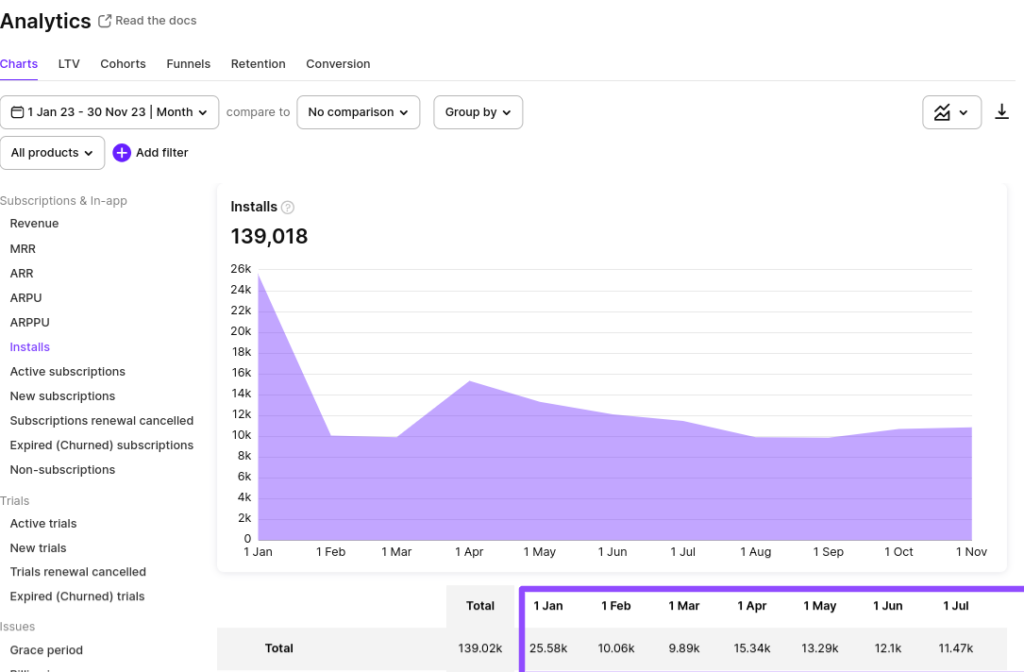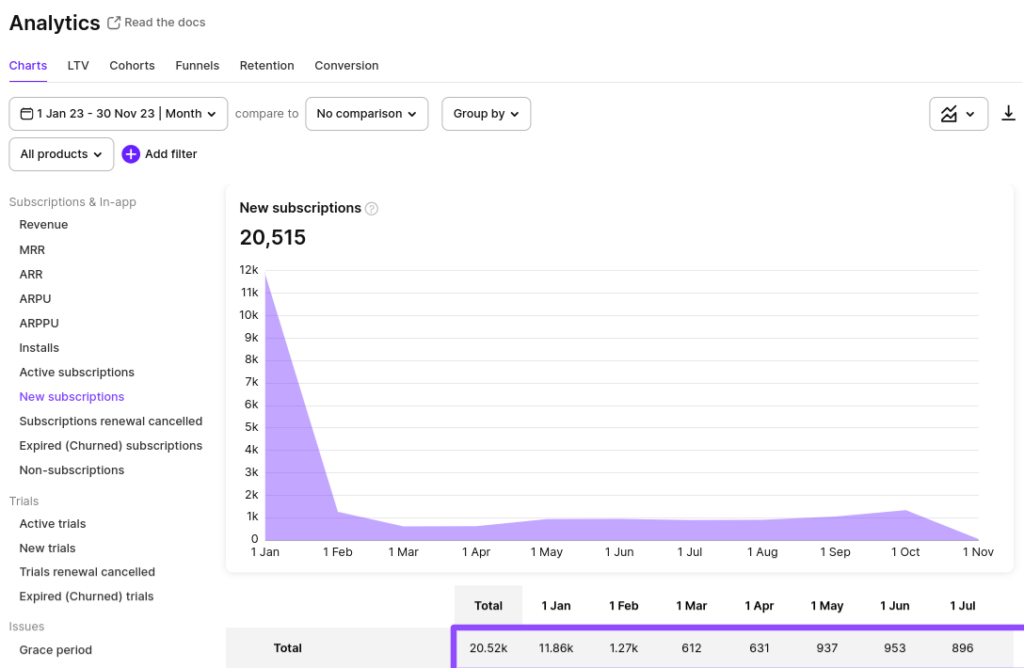Month-over-month growth: metrics and calculation formula

March 7, 2024
15 min read

When measuring your mobile app’s performance, many metrics like your conversion rates, retention rates, and monthly active users are best-measured month-over-month.
Tracking these metrics monthly and comparing their performance month over month helps you tie the changes you see to the things you tried during those periods and understand what’s working. If something seems to work, you can see if it’s repeatable and can help you secure immediate short-term wins. Averaging these metrics’ month-over-month performance over a reasonable timeline also enables you to understand how your app is growing and set reasonable growth goals (and accurate projections). In the long term, month-over-month growth trends can help you adapt your strategy and ensure sustainable growth.
All in all, month-over-month growth analysis is essential for both your mobile app’s short-term and long-term performance. In today’s primer on month-over-month growth for mobile apps, we’ll see what month-on-month growth is for a mobile app and how you can calculate it. We’ll also see the common errors that creep into month-over-month analysis and how to avoid them. And more.
Here goes.
What is the month-over-month growth rate?
The month-over-month growth rate for a metric is how it changes (increases or decreases) from one month to the following. Month-over-month growth rates can be calculated for various metrics across the different mobile app marketing funnel stages, like user base from the user acquisition and revenue from the conversion stage to churn or active user base from the retention stage.
Benefits of month-over-month growth metrics
MoM growth analysis works great for managing short-term growth
When you want to grow your mobile app, especially if it’s new, you need to work on multiple channels, from ASO and PR to referral marketing. Many of these strategies produce immediate results, for instance, paid ads. When you track your month-on-month metrics, you can easily tie your growth to your sales and marketing ops. Knowing what works for you can help you sustain your business, at least in the short term. This is especially true when you measure your returns against the investment you make – for instance, looking at user acquisition while monitoring your acquisition costs. Month-over-month analysis is a handy tool here.
MoM growth analysis enables agility
Month-over-month growth rate analysis enables agile decision-making. So you can fine-tune your sales and marketing tops and see their impact almost immediately, in just a month. This means you don’t keep doing things with low returns.
MoM growth analysis can work great for securing long-term growth
When done right, month-on-month analytics can help you identify trends, make adjustments, and continuously improve your strategies for sustainable growth. Additionally, by closely monitoring your spending and returns, you can make informed decisions and build a complete growth engine to get you compounding growth.
How to calculate month-over-month growth rate (MoM)
To calculate your MoM growth rate for a metric, take the metric’s value for the current month, subtract it from the value for the same metric from the previous month, and divide the difference by the last month’s value. MoM is expressed as a percent, making the formula for month-over-month growth rate as this:
MoM growth rate=((Current month’s value of a metric−Previous month’s value of the same metric)/The previous month’s value of the metric) ×100
For example, if you reported adding 500 users in January and 750 in February, your month-over-month growth rate will be calculated as ((750-500)/500)*100, which comes out to be 50%.
Now, let’s say you only managed to have 500 users in March after reporting 750 in February. In this case, your month-over-month growth rate comes out to be -33% (((500-750)/750)*100). This is “negative” growth.
Finally, let’s assume you added 650 users in April after bringing in 500 users in March. So, in this case, you’re looking at a month-over-month growth rate of 30% (((650-500)/500)*100).
These calculations show a few caveats when calculating month-over-month metrics.
Common caveats when working with month-over-month growth rates
Month-over-month metrics can fluctuate – a lot
As we just saw in the above example, month-over-month metrics can fluctuate a LOT.
Why?
Let’s say you have a new app, and you’re pumping money into several different strategies each month. And that your successful mobile app PR in January gave you hundreds of new users. For February, you tried paid advertising, which underperformed. In March, you worked on your app store optimization and SEO, which didn’t, at least, immediately add any new users.
While these experiments across different channels can tell you which ones to prioritize, the numbers they bring reflect directly in your month-over-month analysis and skew the entire analysis.
Below you’ve Adapty reporting an app’s installs over 11 months. As you can see, the metric tends to fluctuate a lot when seen from month to month:

Month-over-month metrics may not make sense on a small scale.
If you start with 500 users in January and manage to add 500 more in February, you’re looking at a 100% month-over-month growth rate (going from 500 users to a 1000 users). Calling this your month-over-month rate, even though it is so for this example for this period, would be incorrect. This commonly happens when you’re dealing with small numbers.
Archana Madhavan from Amplitude explains this well: “Huge MoM growth is much easier to achieve with smaller numbers. That means that it’s both easier to construct a narrative around your MoM growth for small numbers and harder to maintain that rate as your business grows.”
Here you’ve Adapty reporting some great new subscription acquisition for an app for its first month. However, the trend doesn’t seem to hold when seen month-over-month and holds only for a very small window of a month:

As we’ll see in just a bit, calculating average month-over-month growth rates helps with this, but only to an extent.
Month-over-month metrics need the context of absolute numbers – almost always.
Let’s say you calculate your month-over-month metrics for your app for an entire year, and it comes out to be a constant 25%. This looks stable and good, but maybe you only have about 1000 users at the end of the year. Which means even with a month-over-month growth rate of 25%, just how many users could you be looking at after the entire year? About 15000ish, by the way. This “future value” is calculated using the future value formula, which we’ll see in the next section.
In most cases, month–over–month growth metrics can be mistelling. It’s best to report MoM along with absolute numbers for more context and accurate reporting.
Below, you’ve Adapty reporting an app’s revenue data. It seems this app started extremely well but then the revenue started to drop. However, when you see the actual numbers (without focusing on the month-over-month negative trends), you can see that it’s still stably making about $35k-ish a month.

2024 subscription benchmarks and insights
Get your free copy of our latest subscription report to stay ahead in 2024.
How compounding month-over-month growth formula (CMGR) helps make sense of month-over-month growth trends
As you just saw, month-over-month growth rates can be very volatile.
Factors like seasonality further add to it.
Because month-over-month growth rates can be so inconsistent, it’s common to calculate a compounding monthly growth rate. Compounding monthly growth rate, or CMGR, is your average month-over-month growth rate.
Here’s how to calculate your CMGR:
CMGR = (The final month’s value for a metric /The initial month’s value for the same metric) ^ (1/The number of months for the compounding average)–1
So, for example, if you had 1000 monthly active users at the end of January and then 5000 at the end of December, you’d calculate your CMGR using [(5000/1000) ^ (1/12) – 1] * 100, which comes out to be 14.35%.
It’s common to use CMGR to project an app’s growth trajectory. Let’s take this example forward. So, let’s say you want to use CMGR to estimate what your user base will look like after three years. To do so, you’ll need to use the “future value” formula.
Future value = Current value(1+Compound growth rate)^ Period of the projection in months
In this case, we’ll apply the CMGR rate for 36 months on the initial period’s value for the metric: 5000(1 + .14)^36, coming out to be over 100,000 users in three years.
Note, however, that it’s always easier to make a projection using CMGR than to build a growth engine that sustains a good CMGR consistently over the projected period. This is one thing to be careful about when using the CMGR metric for planning your app’s trajectory.
Compound vs. linear month-over-month growth
Another concept that often comes up when discussing a business’s MoM metrics or its compounding monthly growth rate is “linear growth.” So, what’s linear growth? Linear growth is growth that happens at a fixed rate. For example, you have a linear growth pattern if you start at 1000 users and add 1000 more to your user base each month. At the end of 12 months, you’ll have a user base of about 12,000.
Reviewing your MoM growth rate trend tells you whether you have exponential or linear growth.
For instance, in this example, if you calculate your MoM growth rate between January and February, it’ll be 100% (((2000-1000)/1000)*100).
Likewise, between February and March, it’ll be about 50% (((3000-2000)/2000)*100).
Similarly, your MoM growth rate for March and April will be (((4000-3000)/3000)*100), i.e., 33%.
If you calculate your CMGR for this example, you’ll be looking at about 12%. But if you were to project growth for a year using your CMGR, you should look at over 45000 users for the projected period. Just plug this example’s data into the future value formula, and you’ll see how (12000(1+.12)^12)).
But in reality, your user base is only growing by 1000 users a month, so if nothing changes, you’d be only looking at a user base of 24,000 users.
You get the drift.
While less exciting than exponential or compounding growth, linear growth can be a sustainable growth pattern for a mobile app. But knowing how you’re growing helps you set realistic goals.
A declining trend in MoM growth rates is, in fact, a potential indicator of your app growth’s linear pattern.
Three Growth Metrics You Should Measure MoM
Here are three growth metrics you should track on a month-over-month basis. Doing so doesn’t just give you immediately actionable insights but also helps you understand the impact of changes you’ve made, any trends that might exist, and help you make informed decisions about future strategies.
Conversion rates
If you monetize your app with in-app purchases, your conversion rate is one of the first metrics you’d want to monitor month-over-month. With the revenue metric, you want to see a positive trend, i.e., you want it to grow each month. Note that some strategies can immediately impact your revenue month-over-month growth rate. For example, if you launch an offer, you’ll see more revenue for that particular month. If you introduce more products, again, you might see a spike in in-app purchases that will reflect in the month’s growth rate. Likewise, if you introduce a new plan, you could see higher revenue as a result. Tie the month-over-month growth rates you see to the marketing and sales strategies you used around those periods. Also, remember that many strategies aren’t repeatable or particularly sustainable.
Retention rate
If you’ve got a subscription-based app, you’d want to monitor how your retention rate performs using month-over-month analysis. Again, a positive trend here means you have a good app, and users like how you’re building upon it (because that’s why they’re staying). Negative trends can highlight many things, from issues with user acquisition and onboarding to low customer satisfaction.
Monthly active users (MAU)
The MAU metric tracks the number of unique users who engage with your app within a month. While this looks like and is a product metric, it ties directly to revenue. Observing changes in MAU can help you gauge the effectiveness of your user acquisition strategies. For example, if you’re acquiring quality users, you should see solid activity levels. This metric underlines how engaged your existing user base is. A drop in this metric for a particular month could mean many things. Did you end up launching a buggy update? Did you launch a redesign that didn’t go down well with your users? Did something happen in the market?
Wrapping it up…
One thing to keep in mind when using month-over-month growth analysis for your mobile app is that you don’t just want to maintain your month-to-month “performance” or hit your monthly or short-term growth goals.
You need to zoom out and see the bigger picture, too. Fixating on maintaining your MoM metrics can come at the cost of long-term exponential growth as efforts that would otherwise go into experimentation only get spent on retaining the immediate metrics.
So capitalize on the immediate opportunities that MoM analysis shows you, but at all times, keep an eye on where you see your app in a year or a few years. That’s the best use of MoM metrics for realizing short-term and long-term growth.
While we’re at it, get in touch with your team for a personalized walkthrough of Adapty and how its out-of-the-box reporting can keep you on top of your MoM analysis and set your app up for growth.
Recommended posts







